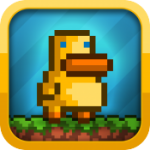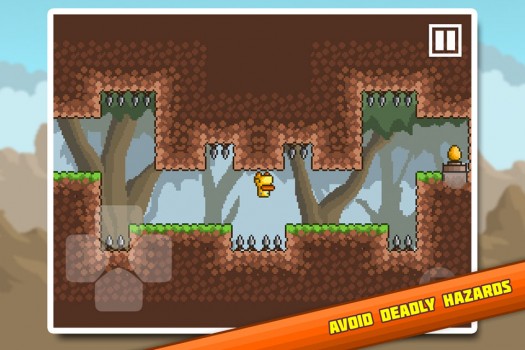 Ravenous Games’ Gravity Duck ($2.99) is the sort of game you already know if you’ve played indie PC gaming favorite VVVVVV – you’ve got happy pixelly graphics, the ability to jump’s been replaced with a gravity-reversal mechanic that slings you from floor to ceiling, and even the same treacherous spikes litter the landscapes. Okay, there are a few differences. For one thing, this time around, you’re playing the part of a duck.
Ravenous Games’ Gravity Duck ($2.99) is the sort of game you already know if you’ve played indie PC gaming favorite VVVVVV – you’ve got happy pixelly graphics, the ability to jump’s been replaced with a gravity-reversal mechanic that slings you from floor to ceiling, and even the same treacherous spikes litter the landscapes. Okay, there are a few differences. For one thing, this time around, you’re playing the part of a duck.
Our brave hero Mr. Duck is told, by a talking stone head, to retrieve golden eggs. The same head imbues him with the power to flip gravity. Why are there eggs and why does a stone head want them and why does he feel a duck is his best bet at retrieving them? you may ask, as I did. So this isn’t exactly the Dickens of iOS, but hey – you and I are more interested in the badassery of flipping gravity, right?
First impressions of Gravity Duck are unlikely to fall flat – the interface is delightfully uncluttered, the music chirpy, and the graphics wonderfully styled (small touches, such as our waddling hero’s “shrinking” animation upon collecting an egg, really add to Gravity Duck’s charm). In this altered platformer, the whole gravity-flip thing is initially a breeze for inexperienced players to pick up. Levels are short, and your goal is to navigate the spike pits, get to the end of each to pick up the golden egg, and warp through to the next level.
Things get more interesting, though, with the introduction of various obstacles. You’ll soon run into adorable monsters, intent on impeding your egg-collection quest. Little hovering winged things spit at you what I can only assume is deadly, solidified saliva, while cavemen resembling angry marching skulls will happily plough through you if you stand in their way.
Further complicating things is a sort of portal, used to rotate your field of gravity 90 degrees. This is probably what distinguishes Gravity Duck from other gravity-inverting platformers; here, instead of just the usual up-down path of travel, you’ll be able to ping-pong from side-to-side as well, which should theoretically add several more layers of complexity to the puzzles.
Of course, I do say “theoretically” for a reason. With three differently themed worlds for Mr. Duck to explore, each consisting of 36 levels, there should be ample room for the difficulty of levels to ramp up. Unfortunately, puzzle progression feels kind of half-baked and poorly planned. In the first world, you might spend ten minutes traversing the obstacles of one level, only to instantly pass the next.
Gravity Duck’s occasional moments of challenge – and there aren’t a lot of them – are more based around the player’s twitch skills rather than in the level design. Even in the later levels, things never feel like they’re verging on too difficult, and there’s never a true test of the player’s puzzling skills. It’s always a little too linear, a little too obvious how you should get through a level – it’s just a question of how well you can dodge monsters on your way to that big, glowing exit sign.
You’ll still die a lot, though, and Mr. Duck’s deaths are made kind of satisfying by the bubble-bursting sound he makes when he is, say, impaled upon spikes. Many of those deaths will come from fumbling with the controls, however. The on-screen d-pad, already an antiquated way of controlling characters on our cool smartphones, feels big and clumsy on the iPad, not ergonomically designed; this small-fingered reviewer had trouble holding her iPad and controlling the duck at the same time, as some of the buttons were too far for her thumbs to reach comfortably. While this problem is eliminated on the iPhone, another issue comes into play on that particular device – the controls occasionally feel kind of unresponsive, tickling your frustration by propelling you into a spike-filled trench even if you’re desperately trying to veer Mr. Duck away from certain death.
It’s a pity – Gravity Duck has such style, and the four-way-gravity gameplay holds a lot of potential for puzzle-solving. Unfortunately, unlocking unchallenging levels never feels like much of an accomplishment, and difficulty levels remain ho-hum throughout the entire game. If you pick this one up, do it for the hypercute aesthetic and hope that, somewhere out there, a more daunting level pack is in the works.

